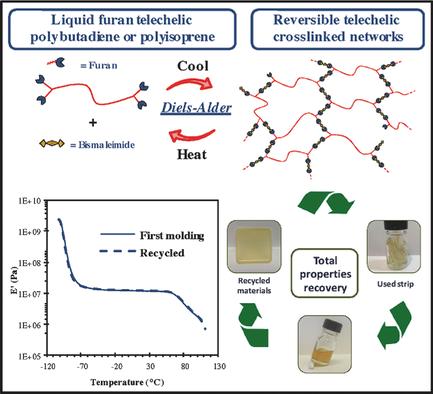当前位置:
X-MOL 学术
›
Macromol. Rapid Commun.
›
论文详情
Our official English website, www.x-mol.net, welcomes your feedback! (Note: you will need to create a separate account there.)
Telechelic Polybutadienes or Polyisoprenes Precursors for Recyclable Elastomeric Networks
Macromolecular Rapid Communications ( IF 4.6 ) Pub Date : 2017-10-12 , DOI: 10.1002/marc.201700475 Pierre Berto 1 , Stéphane Grelier 1 , Frédéric Peruch 1
Macromolecular Rapid Communications ( IF 4.6 ) Pub Date : 2017-10-12 , DOI: 10.1002/marc.201700475 Pierre Berto 1 , Stéphane Grelier 1 , Frédéric Peruch 1
Affiliation

|
(Bis)furan‐telechelic, low‐molar‐mass polybutadienes and polyisoprenes are synthesized by controlled degradation of high molar mass polymers and chain‐end modifications yielding difunctional, trifunctional, or tetrafunctional polymers. Addition of a bismaleimide to the liquid‐modified polymer leads to the formation of a thermoreversible elastomeric network based on the Diels–Alder chemistry for the trifunctional or tetrafunctional polymers, whereas only chain extension occurs for the bifunctional one. Dynamic mechanical analyses or tensile tests are performed on the networks and reveal a similar behavior for polyisoprene and polybutadiene with nevertheless quite different Young modulus or strain at break. The retro Diels–Alder reaction occurs upon heating, allowing the remolding of the used elastomer. The remolded network exhibits the same mechanical properties as the initial network, showing an efficient material recyclability.
中文翻译:

用于可回收弹性网络的远螯聚丁二烯或聚异戊二烯前体
(双(呋喃)-呋喃苯甲酸酯,低摩尔质量的聚丁二烯和聚异戊二烯)是通过高分子量聚合物的受控降解和链端修饰而合成的,从而产生双官能,三官能或四官能聚合物。在液体改性的聚合物中添加双马来酰亚胺会导致基于Diels-Alder化学的三官能或四官能聚合物形成热可逆的弹性体网络,而双官能的仅发生扩链。在网络上进行了动态力学分析或拉伸试验,结果表明,聚异戊二烯和聚丁二烯的行为相似,但杨氏模量或断裂应变却大不相同。加热后会发生Diels–Alder逆反应,从而可以重新成型用过的弹性体。
更新日期:2017-10-12
中文翻译:

用于可回收弹性网络的远螯聚丁二烯或聚异戊二烯前体
(双(呋喃)-呋喃苯甲酸酯,低摩尔质量的聚丁二烯和聚异戊二烯)是通过高分子量聚合物的受控降解和链端修饰而合成的,从而产生双官能,三官能或四官能聚合物。在液体改性的聚合物中添加双马来酰亚胺会导致基于Diels-Alder化学的三官能或四官能聚合物形成热可逆的弹性体网络,而双官能的仅发生扩链。在网络上进行了动态力学分析或拉伸试验,结果表明,聚异戊二烯和聚丁二烯的行为相似,但杨氏模量或断裂应变却大不相同。加热后会发生Diels–Alder逆反应,从而可以重新成型用过的弹性体。

























 京公网安备 11010802027423号
京公网安备 11010802027423号